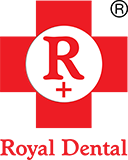
Is your Teeth Brushing technique correct | Royal Dental Clinics
Proper teeth brushing helps to prevent and control the gum disease. It cleans the teeth below the gums where micro-organisms, food debris, plaque tend to gather. You simply follow the basic technique of whichever method you choose, but after brushing an area, you roll or sweep the bristles toward the chewing surfaces.
Maintaining oral hygiene is essential to keep gum diseases at bay. Proper tooth brushing helps to prevent and control the gum disease. It cleans the teeth below the gums where micro-organisms, food debris, plaque tend to gather. Brushing should be performed twice a day irrespective of age. Tooth brush should be change every 3-4 months for efficient plaque control.
Brushing should be started in children as soon as their milk tooth erupts (6 months) either with a soft cloth or soft toothbrush.
Fone’s/sulcular/scrub technique for children suggests:
- The brush move in big circles on outer surface of the teeth and partly in the gums. Initially big circles are made and then reduced to smaller circles.
- Brush the inner surfaces by tilting the brush vertically and making several up and down strokes.
- The chewing surfaces are cleaned by making back and forth strokes.
Modified Bass technique for adults tooth brushing suggests:
- Place the brush at a 45 degree angle towards the gum, on outer surface of teeth and partly on the gums.
- Bristles are vibrated by moving the brush back and forth and in circular motion
- The bristles are then sweeped away over the surfaces of the teeth towards the occlusal/Incisal surfaces. This is very important step as the food particles that get lodged in the gums are effectively removed by the sweeping motion.
- The inside surface of the posterior teeth are cleaned in the same manner.
- The inside surface of front teeth are cleaned by using up and down strokes.
- Chewing surfaces are cleaned by moving the brush in back and forth motion .
- Medium bristle toothbrush is usually indicated for this technique.
Modified Stillman technique for adults suggests for teeth brushing:
- Place the brush at a 45 degree angle towards the gums. Bristles are placed partly on the gums and partly on the cervical portion of the teeth.
- The sides of the bristles are placed firmly rather than the ends. Care is taken not to penetrate the gingival sulcus. Brush is moved with short back and forth circular motion towards the occlusal surface.
- Soft bristle toothbrush is indicated.
Charter’s technique for adults undergone periodontal surgery or with ortho appliances suggests:
- Bristles are placed at 45 degrees angle to the long axis of the teeth in an opposite direction as compared to modified Bass and modified Stillman .i.e the bristles are directed coronally.
- After adaptation the bristles point away from the gingival margin but towards the interproximal surfaces of the teeth.
- After placing the bristles at gingival margin circular strokes are made. Chewing surfaces are cleaned by shirt back and forth strokes.
- Soft/medium bristle toothbrush is indicated for this technique.
This may sound weird, but there are modified versions of the Bass, Stillman and Charter techniques. You simply follow the basic technique of whichever method you choose, but after brushing an area, you roll or sweep the bristles toward the chewing surfaces. This action sweeps out debris stuck between the teeth and cleans the entire tooth surface. The sweeping motion also helps prevent damage to the spaces between teeth and gums.
You may replace your toothbrush every three to four months. Worn, frayed brushes don’t clean well, and older brushes can harbour bacteria. Don’t forget the fluoride toothpaste, which strengthens tooth enamel and prevents tooth decay. And floss at least once a day to clean where your toothbrush doesn’t reach.
Leave a reply


Leave a reply